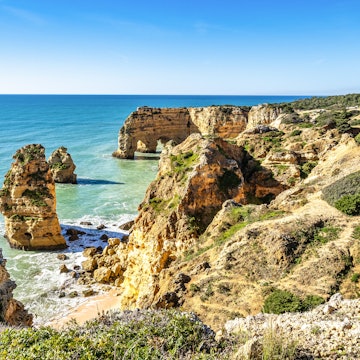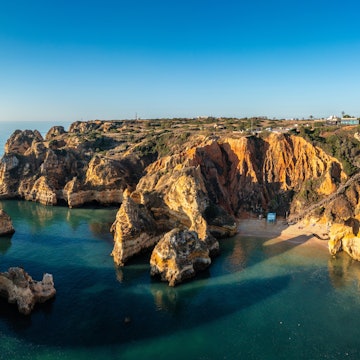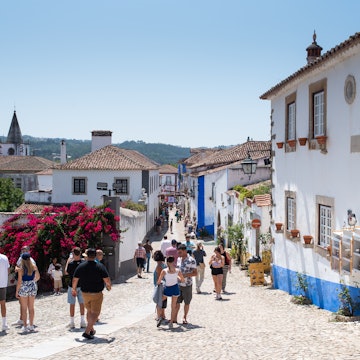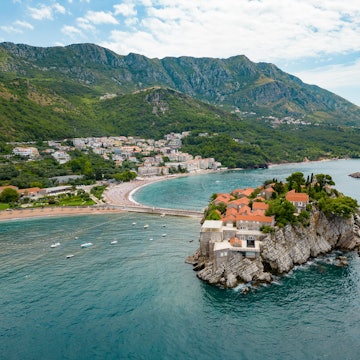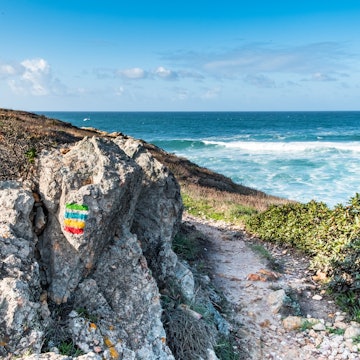
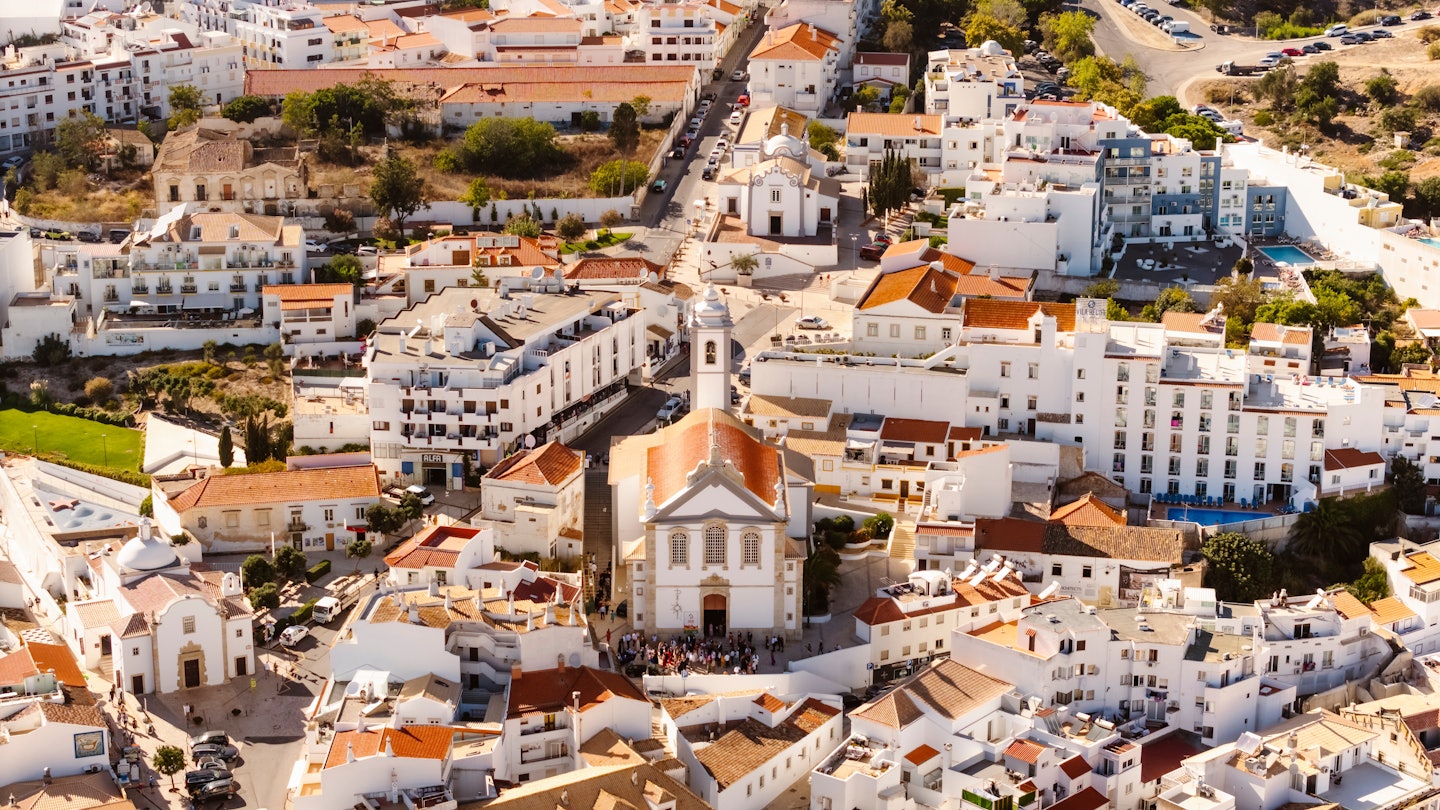
An aerial view of Albufeira’s Old Town. Sopotnicki/Shutterstock
In the 1960s, Albufeira seized the sun, sea and sand package-holiday boom with both hands. It didn’t take long for this traditional fishing village in the Algarve to transform into a fully fledged city and famous beach resort.
Continuing to sprawl outward to accommodate every kind of sunseeker, new neighborhoods of affordable all-inclusive hotels, lavish resorts and the (in)famous stag-party-pleasing strip have sprung up, cementing a sometimes brash and boozy reputation.
Yet the city has reinvented itself before, following both the fall of Moorish Al-Buhera in 1249 and the devastating tsunami triggered by Lisbon’s 1755 earthquake. And now, Albufeira’s current mayor is on a mission to establish his city’s cultural bona fides. New creative enterprises, boutique hotels and even an underwater art gallery have arrived in recent years.
The Algarve’s year-round lifeguarded beaches lure visitors to the Old Town in every season, while architecturally pleasing vineyards and fine-dining wine cellars provide alternatives to animated pubs and clubs. These days, Albufeira is simply a delight – and these are the best things to do there.

1. Visit mini museums and historic sites on a walking tour of the Old Town
While you might have to squint at times to conjure it, this 1.8km-long walking tour will reveal traces of Albufeira’s long history. Start at Albufeira Observation Deck, where you can contemplate the cliffs and golden sands beyond. It’s hard to imagine today, but these once-castle-topped rocks gave the city its Arabic name, Al-Buhera, meaning “castle on the sea.” Set off in search of the relics that remain, tracking the elevated path past a tiled mural depicting knights of yore toward the Museu de Arte Sacra, whose highlights include 16th-century hand-painted religious azulejos, gold-embroidered 20th-century church garments and a particularly striking blue jade altar.
Follow the road downward, popping into the small but lovely Centro de Artes en route to Jardim Público de Albufeira, the Old Town’s main square, and the compact Galeria de Arte Pintor Samora Barros, which usually has a free, Albufeira-themed exhibition. Next, turn left toward the Albufeira Tunnel, which leads to the beach. But rather than heading for the shoreline, climb the stairs to see the small clutch of archaeological discoveries inside teeny Museu Municipal de Arqueologia and, in front, 12th-century remains of low Moorish-built house walls, part of the former castle.
Walk along the ocean-facing path (once the castle’s front) toward the shell-adorned Porta de Sant Ana, one of three former gates destroyed in the 1755 earthquake. Turn right, and pause at the former fish market and fishermen-dedicated Monumento ao Pescador to picture pre-tourism Praia dos Pescadores, dotted with colorful boats. Then, take the outside cliff escalator to Miradouro do Pau da Bandeira for another great view.
Perhaps now, if you squint, you’ll be able to imagine that castle.
Local tip: Continue the chill Old Town vibes over a meal at Café In-certo, a peaceful tapas bar where you can share boards and light bites, delicious sangria and local beers well away from the party bars.

2. Scuba dive through an underwater “art reef”
Boat trips of all kinds – from dolphin watching to booze cruises – depart from Albufeira’s candy-colored marina. You can also take a boat trip from here that will launch you on your scuba-diving path. Whether you’re already qualified or looking for a first-time dive experience, there are two reasons to submerge yourself in Albufeira: Portugal’s largest natural reef, and Art Reef by Vhils, sunk in 2023. Containing sculptures fashioned from parts of a decommissioned power station, the work by Portuguese street artist Vhils is Albufeira’s newest artificial reef – and one shallow enough to be seen on a first-time discovery dive.
With its own in-marina training pool. Easy Divers does exactly as the name promises, providing introductory classes in the pool before everyone lugs their tanks to the spacious boat and heads for the waters. With one instructor per pair of learners and extra attention given to ensuring children also enjoy the experience, it’s a professional and long-standing outfit with which to spend the afternoon.
Planning tip: When booking, confirm the dive-site schedule if you’re committed to exploring the art reef, keeping in mind ocean conditions on the day will dictate the final decision.
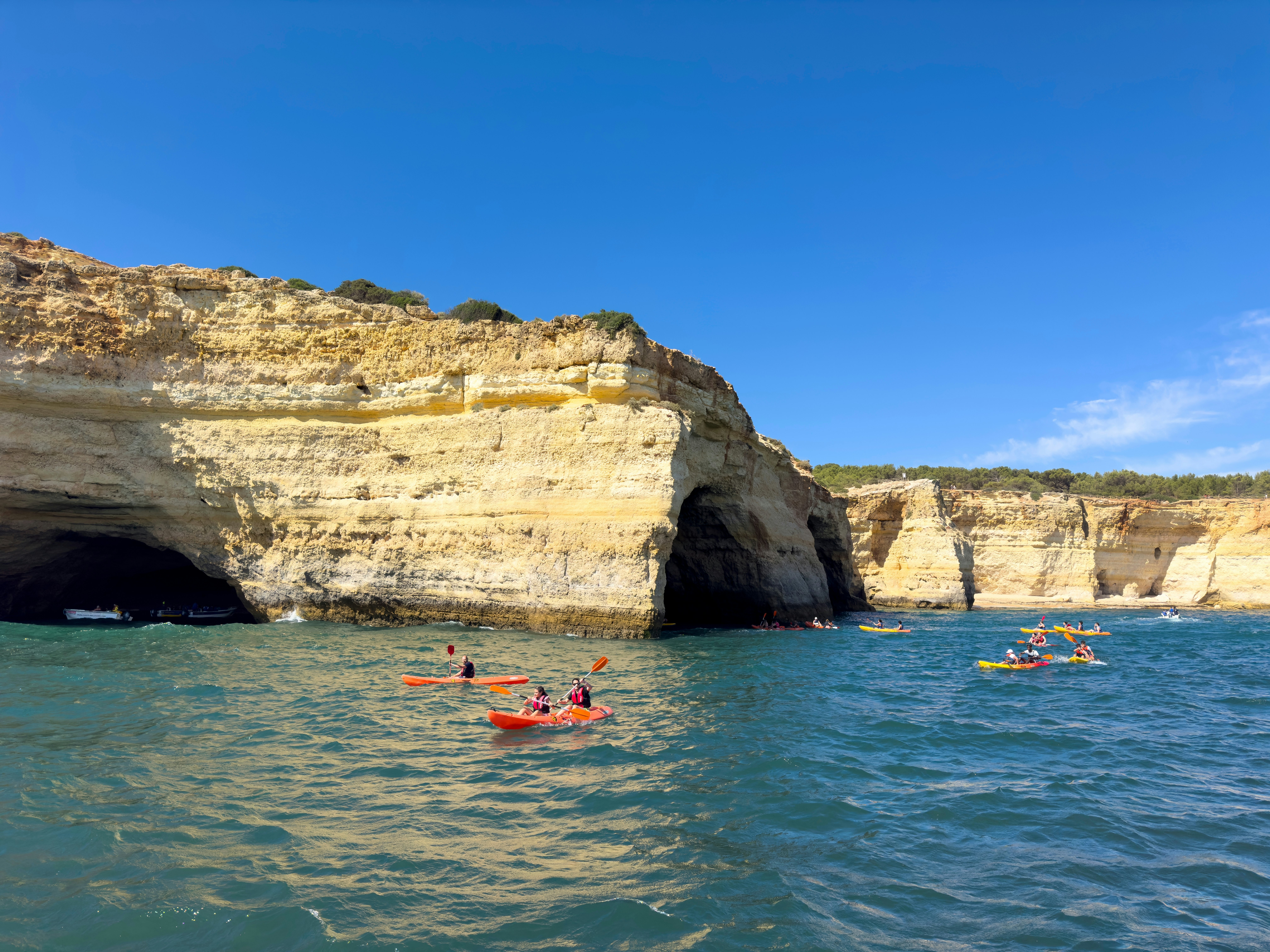
3. See craggy coves and empty beaches on a kayaking tour or coastal trail
Albufeira’s shorelines are renowned for a reason, and you don’t need to stray beyond the Old Town’s Praia dos Pescadores unless you want to. Yet for a wilder string of beaches within easy reach of the center, set your sights west, toward Praia dos Arrifes and Praia da Galé. You can amble between the two on a beach-hopping, cliff-topping trail, visiting handkerchief-sized coves and peering down on impossible-to-access sands along the way.
If you rent a kayak, these otherwise closed-off shores become reachable (and swimmable). Based at Praia de São Rafael, Albufeira Surf Sup offers two- to three-hour group tours by kayak or SUP for those who would prefer to explore the coast by water.
Planning tip: A boat will accompany each excursion to assist first-time kayakers who might need a break.

4. Get a dose of culture at craft workshops in creative spaces
Albufeira’s constant growth as a tourism hot spot means many of its downtown spaces have been turned into bars and restaurants. Yet the repurposing of the city’s former courthouse as the Centro de Artes in late 2023 aims to fill a void by bringing Algarvian artistic heritage back to the Old Town. Inside, there’s a small temporary-exhibition space and shelves selling hand-crafted wares from local artisans. Anna, at the front desk, is always happy to explain the heritage of the craft methods used.
The center (closed on Sundays) also hosts various workshops throughout the year, ranging from one-day ceramic classes to multi-day weaving lessons; check schedules online and reserve spaces in advance.
Local tip: Around the corner, Pau de Pita is one of the town’s best gift shops for locally produced fabrics, ceramics and souvenirs.
5. Sip whites and reds at a family-run winery
There’s no need to travel far to trade Albufeira’s bars for wine barrels. A 15-minute taxi from the Old Town, Quinta do Canhoto is a true family affair; even the striking, white-lined, bioclimatic building was designed by a family member. Tours through the vines are held on weekdays, ending with a four-wine tasting in the breezy interior or shaded garden. Visiting for a picnic among the vines is also possible – but as with the tours, you should book ahead.
Planning tip: Families are especially welcome in summer, when the Quinta do Canhoto team hosts kids’ painting activities – allowing parents to fully savor their tasting.
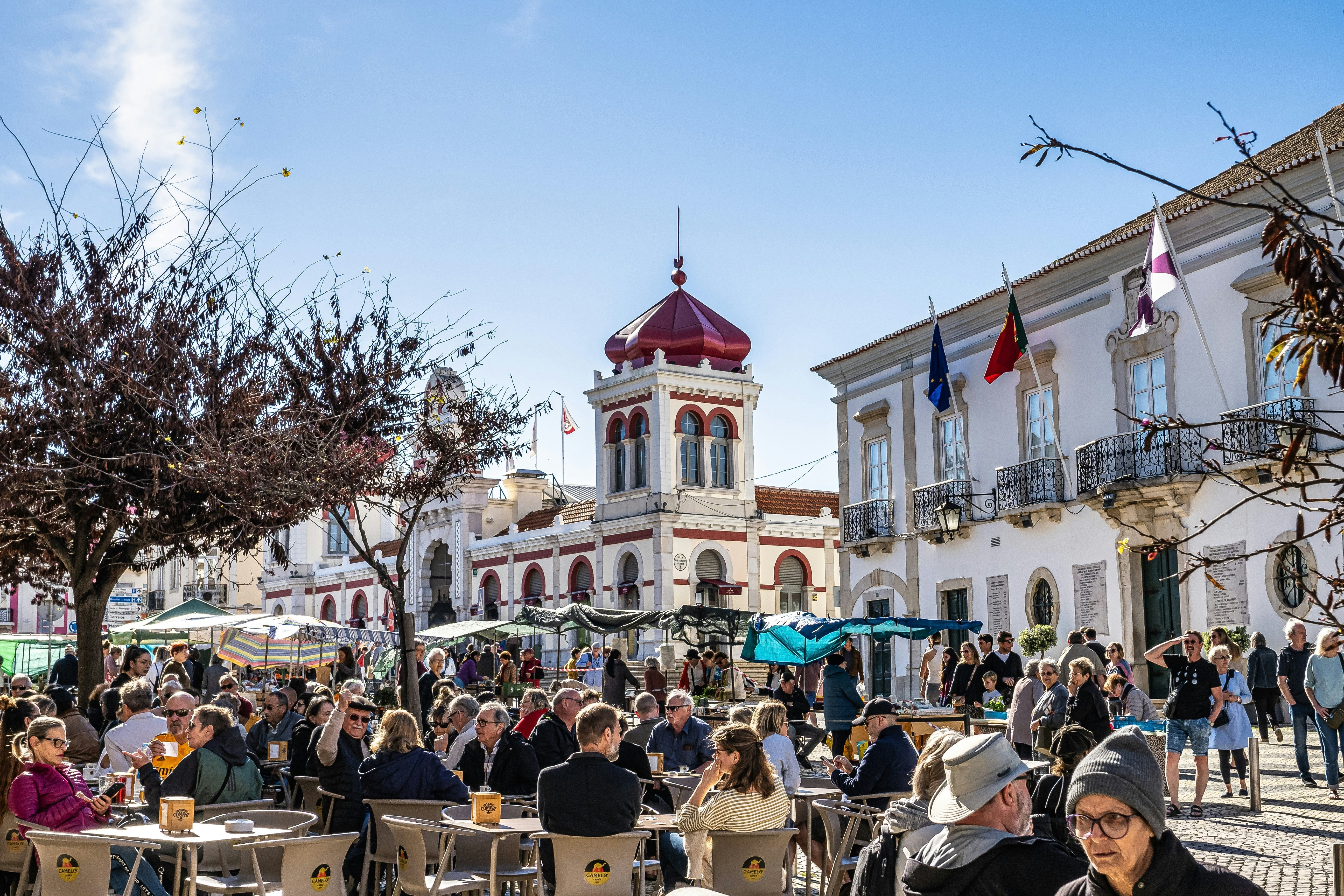
6. Take a day trip to alluring Loulé
A 30-minute drive from Albufeira, the charming inland town of Loulé has long led the preservation of ancestral Algarvian crafts. In 1291, the town established its first trade fair, and today Loulé Criativo promotes time-honored techniques, from tile painting and palm weaving to embroidery and esparto grass braiding.
Crammed with historic sights, Loulé’s compact center is essentially an open-air museum. Introduce yourself to the town’s history at the Museu Municipal, housed in part inside the reconstructed Moorish Castle. The ground floor focuses on Roman and Islamic archeological discoveries, while upstairs has a recreated traditional Algarvian kitchen and access to the external castle tower. Opposite, the teeny, azulejo-adorned Ermida de Nossa Senhora da Conceição is worth a peek. Most noteworthy is the Banhos Islâmicos de Loulé – the only (known) example of Islamic baths in Portugal, now covered by the museum constructed around the archaeological site.
Opened in 1908, Loulé’s Mercado Municipal has arched Moorish doorways, onion-dome-topped towers and a fluttering rainbow of fabrics that make it the region’s most famous. Fresh, local produce is always plentiful, alongside a few food-market-style restaurants. Yet it’s Saturday mornings when the market is most animated, spilling onto the streets with local traders selling everything from fruit-infused honey to homemade cheeses.
Planning tip: Time your visit to Loulé’s crowded cultural calendar. Here, the Algarve’s largest, loudest and most colorful Carnaval features huge floats, dance troupes and marching bands. In the Easter season, the more solemn Festa da Mãe Soberana is one of Portugal’s largest processions. Festival MED, a celebration of world music, arrives in June, followed by July’s Jazz Festival.

7. Seek out some of the less wild spots on the Strip
Brash, covered with neon signs and certainly not for everyone, the Strip in Oura is Albufeira’s most lively (or, depending on your point of view, notorious) street, where beers flow freely and patrons can get a bit…raucous. Yet among the lively, overspilling bars, there are a few calmer picks. On a first-floor balcony, Connection is Albufeira’s main LGBTQ+ bar, while Libertos has a tree-shaded cocktail garden that’s relatively calm (before midnight, at least). Longo Cocktail Lounge, a short walk from the main madness, offers a more local and relaxed vibe and terrace.
Planning tip: Your Albufeira experience will be defined by where you stay. Oura’s hedonistic, late-night strip lies 2km east of the Old Town, which is equally animated in summer. Pick Galé, São Rafael or Olhos de Água for more serenity.
This article was adapted from Lonely Planet’s Portugal guidebook, published in March 2025.








